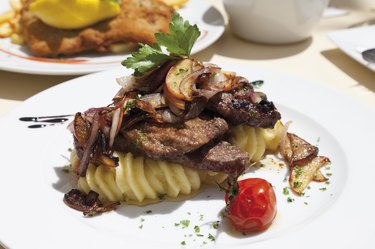
Lamb's liver and calves liver, also called veal liver, are both nutrient-rich protein sources that are relatively low in fat. While lamb liver is milder tasting than calf liver, it can be cooked in a similar fashion, most frequently sauteed. Calf liver has a slightly sweeter taste than lamb liver, although both are equal in terms of tenderness.
Calories and Protein
Video of the Day
Both lamb and calf liver have similar calories and macronutrients for a 3-ounce serving. A serving of lamb liver has 118 calories, while calf liver has 119 calories. Lamb liver has 17.3 grams of protein, while calves liver has 17 grams of protein. Neither contains any dietary fiber. The Centers for Disease Control and Prevention says that adult women require 46 grams of protein per day, while adult men require 56 grams of protein.
Video of the Day
Fat and Cholesterol
A 3-ounce serving of lamb liver has 4.3 grams of total fat and calf liver has 4.1 grams of total fat for the same-sized serving. In both cases, the majority of the fat is saturated fat. Lamb liver has 314 milligrams of cholesterol per 3-ounce serving, while calf liver has 284 milligrams. The American Heart Association recommends that saturated fats make up 7 percent or less of your daily caloric intake. For a 2,000-calorie-per-day diet, that means no more than 16 grams of saturated fat per day. The AHA recommends limiting your daily cholesterol intake to no more than 300 milligrams or fewer than 200 milligrams for those which high cholesterol levels or a history of heart disease.
High in Iron
Both types of liver are a good source of iron. Iron is considered an essential mineral, as it is needed to create blood cells. It helps produce a number of proteins in your body, including hemoglobin and myoglobin, which carry oxygen and transport it throughout your system. The recommended intake of iron is 8 milligrams for adult women over 51 and for all adult men. For women under 50 years of age, the recommendation is 18 milligrams. Lamb liver contains slightly more iron per serving, with 6.25 milligrams for a 3-ounce serving. In turn, calf liver has 5.44 milligrams of iron per same-sized serving.
Vitamin A Content
Liver is an excellent source of vitamin A. Vitamin A is necessary for good vision and defends your body's cells from damage from free radicals, produced as your body breaks down food. Free radicals can cause disease such as osteoporosis and cancer. The recommended dietary allowance of vitamin A is between 700 and 1,300 micrograms for all adults. A single 3-ounce serving of either liver provides well over 100 percent of the RDA for all adults. Because it is so high in vitamin A, overconsumption can lead to vitamin A toxicity, the symptoms of which are nausea, headaches, skin irritation, pain in joints and bones, coma and possibly death.
- U.S. Department of Agriculture: Lamb, Variety Meats and By-Products, Liver, Raw
- USDA: 17202, Veal, Variety Meats And By-Products, Liver, Raw
- ChooseMyPlate.gov: How Many Foods From The Protein Foods Group Is Needed Daily?
- BBC: Liver Recipes
- Cook's Thesaurus: Liver
- MedlinePlus: Iron in Diet
- Office of Dietary Supplements: Vitamin A
- Centers For Disease Control and Prevention: Protein
- American Heart Association: Know Your Fats
Is this an emergency? If you are experiencing serious medical symptoms, please see the National Library of Medicine’s list of signs you need emergency medical attention or call 911.